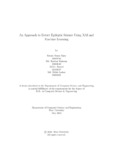An approach to detect epileptic seizure using XAI and machine learning
Abstract
One of the most common neurological disorder in health sector is Epileptic Seizure
(ES) which is occurred by sudden repeated seizures. Hitherto more than 50 million
people in the whole world are suffering from Epileptic Seizures. The abnormal
brain activity of the central nervous system often causes unusual behavior, losing
awareness and psychological problems etc. Moreover, many risks associated with
epileptic seizures include sudden unexpected death in epilepsy (SUDEP) which is
really a concerning problem discussed in this article. For abstaining from adverse
consequences of epileptic seizure-like this health sector focuses more on the early
prediction and detection of epilepsy. The complex signals of brain activity are
reflected as swift-passing exalted peaks in Electroencephalogram (EEG). Initially,
the specialist inspects the EEG signals over a few weeks or months to identify
the presence of epileptic seizures, which is a very time-consuming and challenging
task. Hence, Machine learning (ML) based classifiers are capable to categorize EEG
signals and detect seizures along with displaying related perceptible patterns by
maintaining accuracy and efficiency. In order to detect epileptic seizures, EEGbased
signal recognition algorithms had been shown in this paper by applying both
Multi-Class Classification and Binary classification. The algorithms were Decision
Tree Algorithm, Random Forest Algorithm, Multi-Layer Perceptron (MLP) and
K-Nearest Neighbor (KNN), Gradient Boosting Classifier, Gaussian Na¨ıve Bayes,
Complement Na¨ıve Bayes, SGD Classifier, Explainable Artificial Intelligence (XAI),
LIME Algorithm etc. However, K-Nearest Neighbor appears with pretty higher
accuracy in certain conditions.

